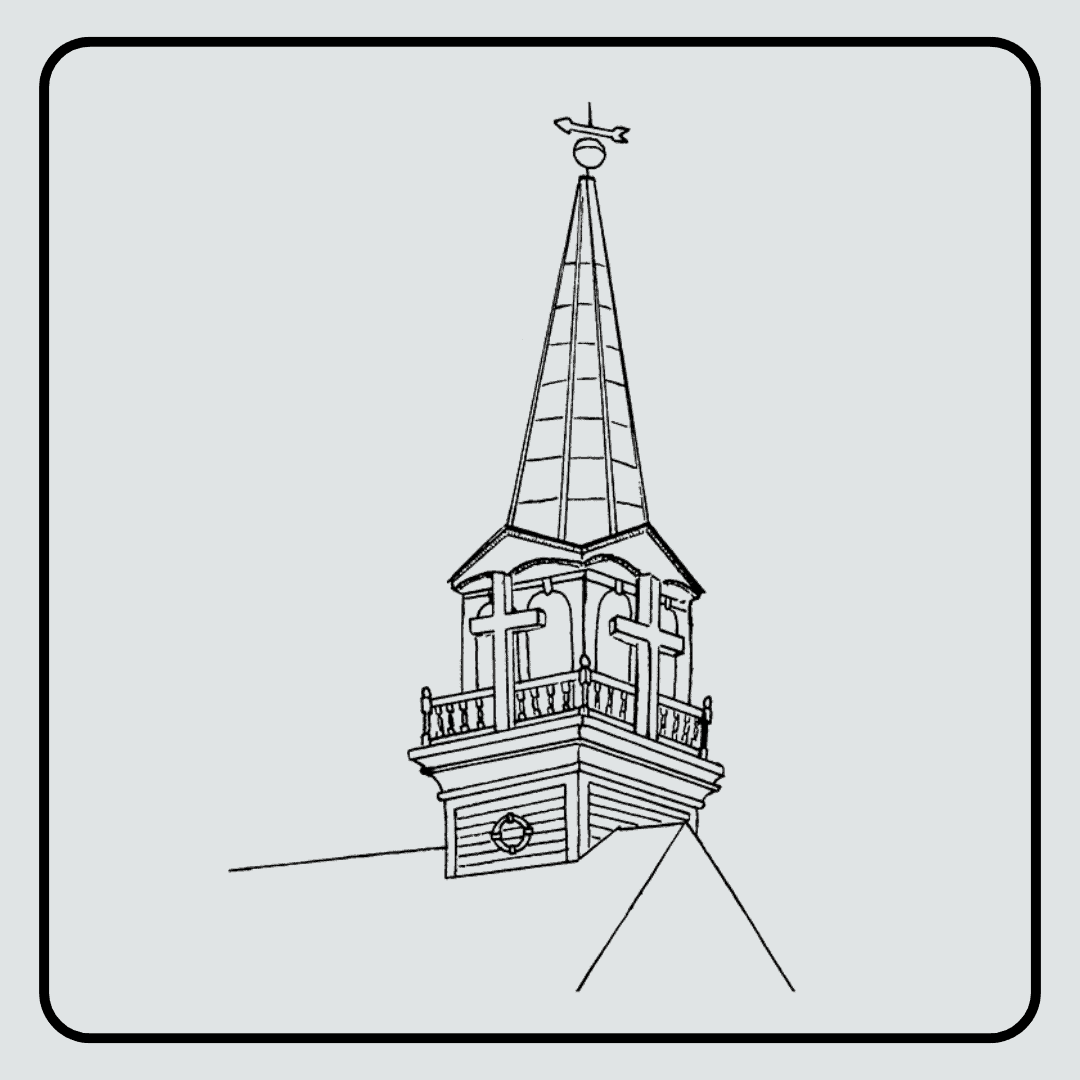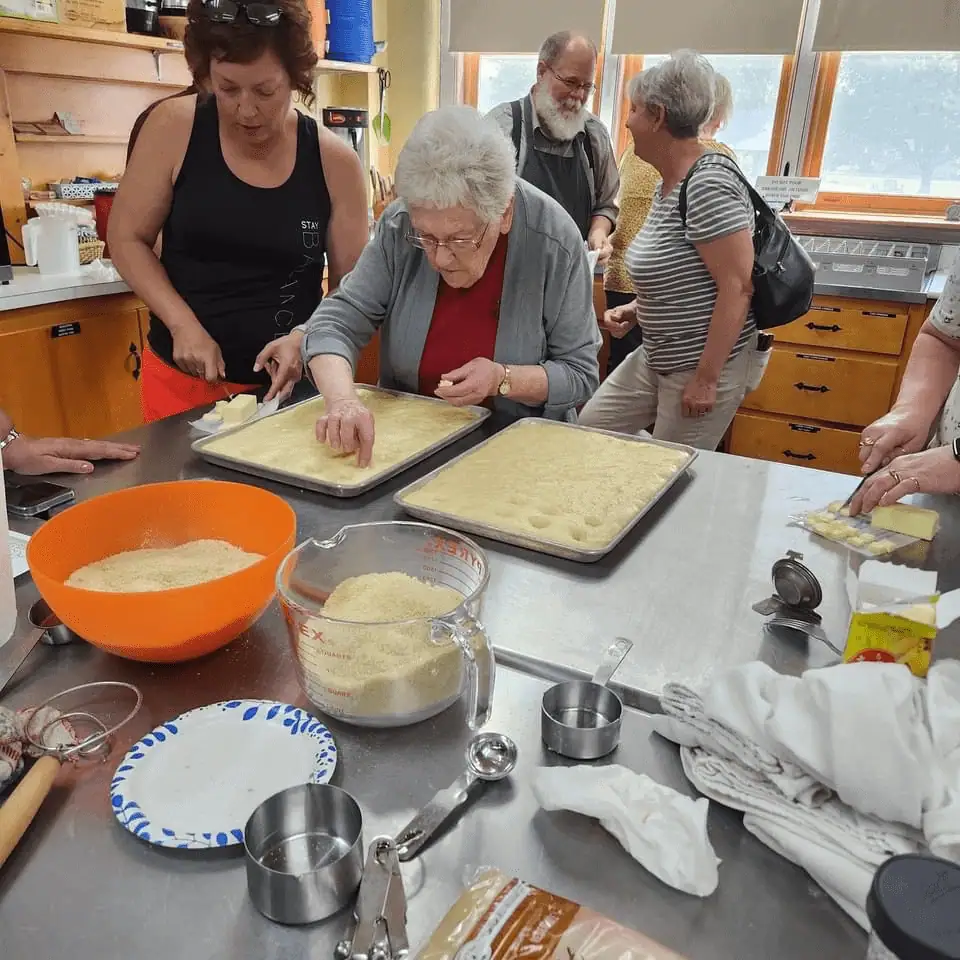The History of Moravian Lovefeasts
The Lovefeast is a worship tradition that traces back to the 18th century in the Moravian Church, and ultimately to the very beginning of the Christian Church.
Lovefeasts originated in the first gatherings of Christians after Pentecost. Those early believers met and broke bread together, in recognition of the unity and equality among all members of the body of Christ.
These meals were called agape meals — from the Greek word for love, specifically the highest type of spiritual love. Gradually the agape meals lost their devotional character, and toward the end of the fourth century the Christian Church stopped holding them altogether.
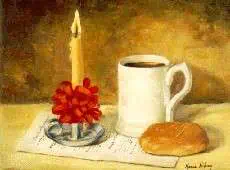
In the Moravian Church, this practice was reinstituted on August 13, 1727 in the community of Herrnhut in Saxony, Germany. During a celebration of Holy Communion, a special outpouring of the Holy Spirit was felt by all in the church.
After worship, many of the participants continued to talk about the great spiritual blessing they had experienced. The groups were reluctant to separate and return to their own homes for the noon–day meal.
Count Nicholas Ludwig von Zinzendorf sent them food from his manor house. Each group partook together while continuing in prayer, religious conversation, and the singing of hymns. A spirit of love and fellowship prevailed over all who were there.
This incident reminded Count Zinzendorf of the ancient agape meals, and the idea was fostered until lovefeasts became a custom in Moravian life. They were introduced wherever new settlements were founded around the world.
The Moravian lovefeast is a service of song at which a simple meal is served to the congregation. This meal, usually some sort of sweet bun and a beverage, is an act of Christian unity, fellowship, and love. It is not a sacrament and it is not a substitute for Holy Communion.
The holding of lovefeasts has come to be one of the most recognizable customs of the Moravian Church. The lovefeast is a simple, devout service which has had a great significance for Moravian for over two and a half centuries.
Modern Lovefeasts
Today, lovefeasts continue to be a celebration of unity and fellowship in Moravian churches around the world. Each lovefeast service has a devotional theme, and the hymns in the lovefeast ode (the order of service) have been chosen specifically to help the congregation reflect on the day’s message.
Often there is no sermon as the hymns themselves furnish the subject matter for devotional thoughts. On special occasions a brief address called a homily may be added, giving the pastor an opportunity to remind the congregation of the deeper import of the day.
The specific items that are served during Lovefeast vary all over the world:
- In the Caribbean Islands you might have a type of raisin scone with ginger beer or tea.
- In England you may have milky tea served in delicate China cups and a biscuit (cookie).
- In Canada you’ll have coffee, tea, or hot chocolate, with assorted baked goods.
- In Dublin, Ireland you will have buns from a local bakery and apple juice.
- In Germany you might have a raisin bun and milky tea.
- In Africa, you may have peanuts.
- In Madison, WI you will have sugar cake and milk.
- In most churches in Pennsylvania, New Jersey, and New York, you will have Moravian sugar cake with coffee, hot chocolate, or chocolate milk.
- In the Southern Province, you will have sweetened coffee with cream (known in the South as “Moravian coffee”) and a sweetened bun.
The kind of food shared isn’t what matters — it is the spirit of unity in Christ and our Christian love for one another that makes the Moravian Lovefeast special. Who you are with and why you are together is what matters most.
Lovefeasts At Schoeneck
Celebrating a Lovefeast is our way to remember how important true community is and how it enables us to do the work of Christ in the world. At Schoeneck we usually serve a piece of Moravian sugar cake with a choice of chocolate milk or lightened decaf coffee (no sugar added).
The lovefeast elements are distributed to the congregation by the Diener Corps while we sing the hymns. The napkin-wrapped pieces of sugarcake are passed along the pews in baskets, each person taking one and passing the basket on. The mugs of coffee are carried on a cart and passed hand to hand by the occupants of the pews. All of the serving activity, and the collecting of the mugs after the partaking, take place while the hymns are being sung.
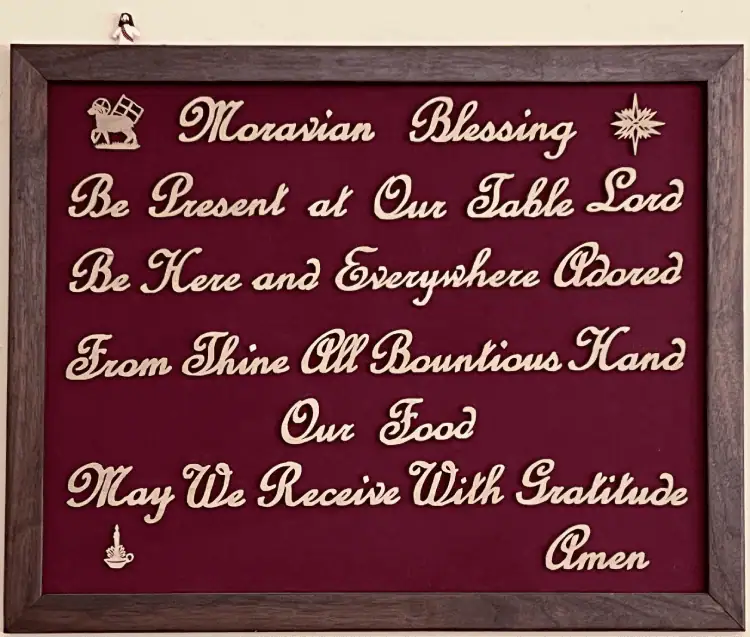
When all are served, a simple blessing is said or sung, and special music is presented while the congregation eats the shared meal. This is done reverently, without hurry, and with an understanding on the part of the congregation of the significance of the activity — that in breaking bread together, we share a spiritual fellowship. When the meal has been finished, the members of the congregation pass the mugs from hand to hand to the aisle, where the Dieners collect them. The Dieners also take the offering during a lovefeast.
Since the elements aren’t consecrated as with Holy Communion, visitors may also partake of the meal with us regardless of age or denomination.
Do You Love To Bake?
Schoeneck conducts ten lovefeast services each year! Years ago, there were several bakeries that made our traditional sugar cake. However, these bakeries have dwindled to a precious few. Two Schoeneck members, Lori Hahn and Terry Berger, proposed the idea of having congregation members make the lovefeast sugar cakes. Before a lovefeast, members of Schoeneck — young and not-so-young, male and female — meet in the church kitchen to bake the sugar cake. You are always welcome to join us! Please watch the bulletins, newsletter, and social media for announcements of when the next group baking session is being held.
Types of Lovefeasts
At Schoeneck, we celebrate more lovefeasts than just about any other Moravian church in the Northern or Southern Provinces! Please click the button below to download a Schedule of Special Worship Services for 2025.

Liturgical Sundays &
Special Occasions
While the Christmas Eve lovefeast is probably the best known of all Moravian lovefeasts, we observe several other important Sundays in the Christian calendar by celebrating a lovefeast.
In addition, there are some special liturgical occasions unique to the Moravian Church that we celebrate. These Sundays are not what would be considered “high holy days” where the sacrament of Holy Communion would be appropriate.
Other lovefeasts are for more secular holidays that we choose to recognize as ones that give us an opportunity to acknowledge God’s goodness and grace in every part of our lives.
Covenanting Days
A Covenanting Day Lovefeast recognizes all of the members of our church who would fit into one of the historical Moravian community Choir groups (Married People, Children, Widows, Single Brother’s etc. See below for more information.) Each lovefeast is a time for modern members of that traditional Choir to both reflect on and renew their covenant with God.
The congregation has an important role in the Covenanting Day Lovfeasts, too. We acknowledge our brothers and sisters in Christ, we affirm they are important and beloved members of our church family, we uphold them in prayer, and we celebrate with them while they rededicate their lives to God.
It is a uniquely Moravian way for us to recognize that together we are one body in Christ Jesus.
Liturgical Sunday Lovefeasts
Great Sabbath Lovefeast
Great Sabbath is the day between Good Friday and Easter Sunday when Jesus was resting in the tomb. For more on the Great Sabbath Lovefeast, please click here.
All Saint’s Lovefeast
All Saint’s Day has a rich and complex history that spans over centuries, involving the Catholic Church, the Christian Church, Protestant churches, and various cultural influences. No matter its origins or interpretations in different denominations, All Saint’s remains a day of reverence. The Moravian Church embraces the celebration of All Saint’s Day as an opportunity to remember and honor all Christians who have gone before, emphasizing the concept of a “communion of saints”. We give thanks to God for the lives of those who have touched us in the past as well as for those who, in the present, continue to encourage and inspire us by their faith.
Christmas Eve Lovefeasts
Our Christmas Eve Lovefeasts feature a reading of the Christmas story from the Bible, many familiar hymns of the season, the beloved antiphonal hymn “Morning Star, O Cheering Sight” featuring a young soloist, and special music from the various voice and instrument choirs in our Music Ministry. Traditional beeswax candles wrapped in red frills are distributed to everyone present for the Candlelight portion of the service. For more on the Christmas Eve Lovefeast & Candlelight Worship Services, please click here.
Special Occasion Lovefeasts
Mission Lovefeast
The Moravian Church has always taken both the Great Commandment (Matthew 22:36-40) and the Great Commission (Matthew 28:16-20) to heart. The Great Commandment and the Great Commission are Christ’s call and direction for how we are to actively live out our faith in the world. We embrace our calling and mission with joy and hope because they brings us ever closer to our Savior and the reign of God on earth.
Whether the Holy Spirit calls us to love and serve our neighbors in our local community or calls us to love and serve our neighbors on another continent, we will joyfully answer that call. At this lovefeast, we celebrate our mission heritage while praying for all current Moravian missions and missionaries.
Christian Family Lovefeast
We remember God’s gift of family through the celebration of our Christian Family Lovefeast. As followers of Jesus Christ, we have been adopted into a new family — the family of God. In this family we are blessed with brothers and sisters of the faith, and we are joined together by our Lord and Savior Jesus Christ. Whether your family size is one, two, four, or ten, we affirm the central role of our Lord and Savior Jesus Christ in our homes, and our place in the family of Christ, the Church, with the Moravian Lovefeast.
Anniversary Lovefeast
Our church was founded and consecrated on October 3, 1762. Each year we celebrate the anniversary of our church’s founding with our Anniversary Lovefeast. Our worship is a joyful celebration of our life together as a church family, and our continuing witness and ministry to the greater Nazareth community. It is a time for our congregation to renew our commitment to our mission of following the example of our Lord and Savior Jesus Christ in loving and serving all.
Thanksgiving Eve Lovefeast
The actual definition of the word “thanksgiving” is the expression of gratitude, especially to God. We hold a Thanksgiving Eve Lovefeast to offer God our praises and acknowledge to Him that He is the Giver of every good and perfect gift. For more on the Thanksgiving Eve Lovefeast, please click here.
New Year’s Eve Lovefeast
Filled with songs and prayers thanking God for the outgoing year and looking with hope towards the incoming year, our New Year’s Eve Lovefeast is a wonderful way to ring in the New Year. For more on the New Year’s Eve Lovefeast, please click here.
Covenanting Day Lovefeasts
About The Moravian Choir System
In the past, the members of Moravian communities were divided into communal living groups called Choirs. The use of the word “choir” was used to describe groups of people — organized according to age, gender, and marital status — who ate, worked, worshiped, attended school, and lived in together in dormitories. This communal living arrangement was intended to strengthen the unity of the Moravian society as a whole. It was believed that individuals of like age, gender, and circumstances were best prepared to encourage each other and to foster religious growth more successfully in each other.
Children’s Lovefeast
During our Children’s Lovefeast, we affirm the children of our church family. We recognize that the children and youth of our congregation are not just the future of the church, but they are an important part of our congregation here and now. We sing some songs that kids of all ages love to sing, and sugar cookies are served in place of Moravian Sugarcake.
Married People’s Lovefeast
The Married People’s Lovefeast is an opportunity for the congregation to support and uphold the people in our church family who are married. We pray that God would continue to bless, strengthen, and bring joy to their marriages. We celebrate this lovefeast in June each year because traditionally June is a very popular month for people to get married.
Single Brothers’ & Single Sisters’ Lovefeast
Today’s modern world can be a challenging place for the Single Brothers and Single Sisters in our congregation. It’s easy to get lost in the shuffle when so much of society is oriented around family life. Our Single Brothers’ and Single Sister’s lovefeast is a way to acknowledge these important members of Schoeneck — to say we see you, we are here for you however you need us, and we uphold you as our brothers and sisters in Christ.
Widows’ & Widowers’ Lovefeast
Losing a spouse or partner changes your life in so many different ways. The Widows’ and Widowers lovefeast lets those in our congregation who have lost their spouse or partner know that they never have to walk alone. This covenanting day lovefeast is a way for the entire congregation to affirm that they, and the loved one they lost, are still important to us. We share their grief, uphold them in our prayers, and we will be here for them as they continue their faith journey.
The Diener Corps
Would you like to be a part of history and tradition at Schoeneck? Consider joining our Diener Corps. No experience necessary!
Schoeneck holds more lovefeasts than many of the churches in the Northern Province. In the true meaning of lovefeasts, which is an expression of common unity and equality in Christ and love for one another, every member of the Diener Corps is an integral part of the overall success of the team. We are currently looking for more members of the Diener Corps to share our lovefeasts with the congregation.
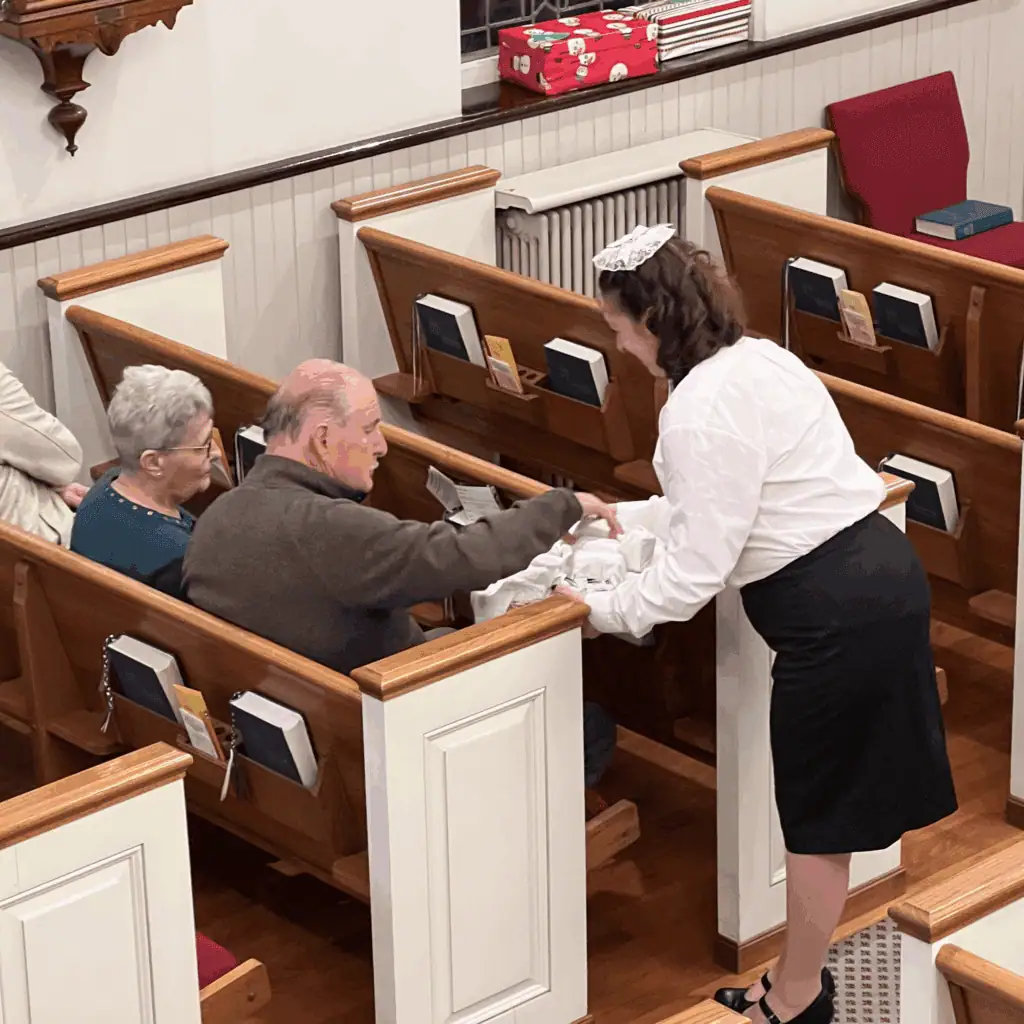
Who Are The Dieners?
In the Moravian Church there is a special corps of volunteers called “Dieners” (German for serve), whose responsibility it is to distribute the sugarcake and mugs of coffee to the congregation during a lovefeast service.
Dieners work in pairs. In the past the Diener Corps was traditionally composed only of married couples. But today everyone is welcome! Dieners can be a couple, father & son/daughter, mother & son/daughter, grandparent & grandchild, siblings, cousins, friends — ALL are welcome to join the Diener Corps. Youth (grades 8 and up) are especially invited to join the Diener Corps. If you want to be a Diener, but don’t have a partner, we will find a partner for you!
Please fill out the Interest Form at the bottom of the page if you would like join to the Diener Corps.
What Do Dieners Do?
The Dieners arrive 30 minutes prior to worship to prepare the lovefeast elements — wrap sugar cake in napkins, make coffee, then pour coffee and chocolate milk into mugs. During the service, they bring out the sugar cake and mugs to serve to the congregation. Handmade wooden carts have replaced the traditional (but heavy!) trays for the mugs. Dieners also collect the offering.
After the service, they clean up — mugs go in the dishwasher. All told, the time commitment for your average Lovefeast Sunday is about two hours, which includes the worship service itself. Veteran pairs will always be a part of the team if you have any questions or concerns.
Dieners are also part of the magic of our Christmas Eve Lovefeast services. They serve the Lovefeast elements, but they also distribute our traditional beeswax candles. Who doesn’t love that moment when the doors are opened to see the Dieners lit by the glow of candlelight?
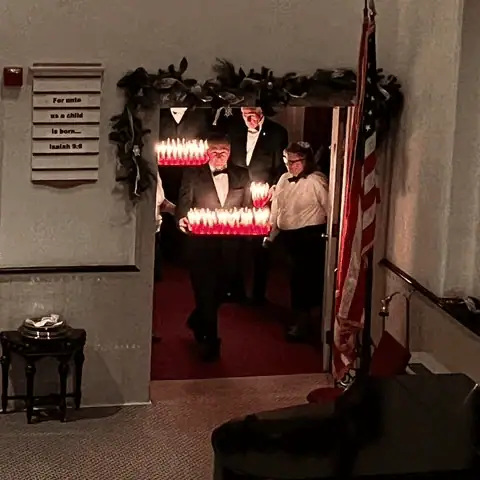
What Do Dieners Wear?
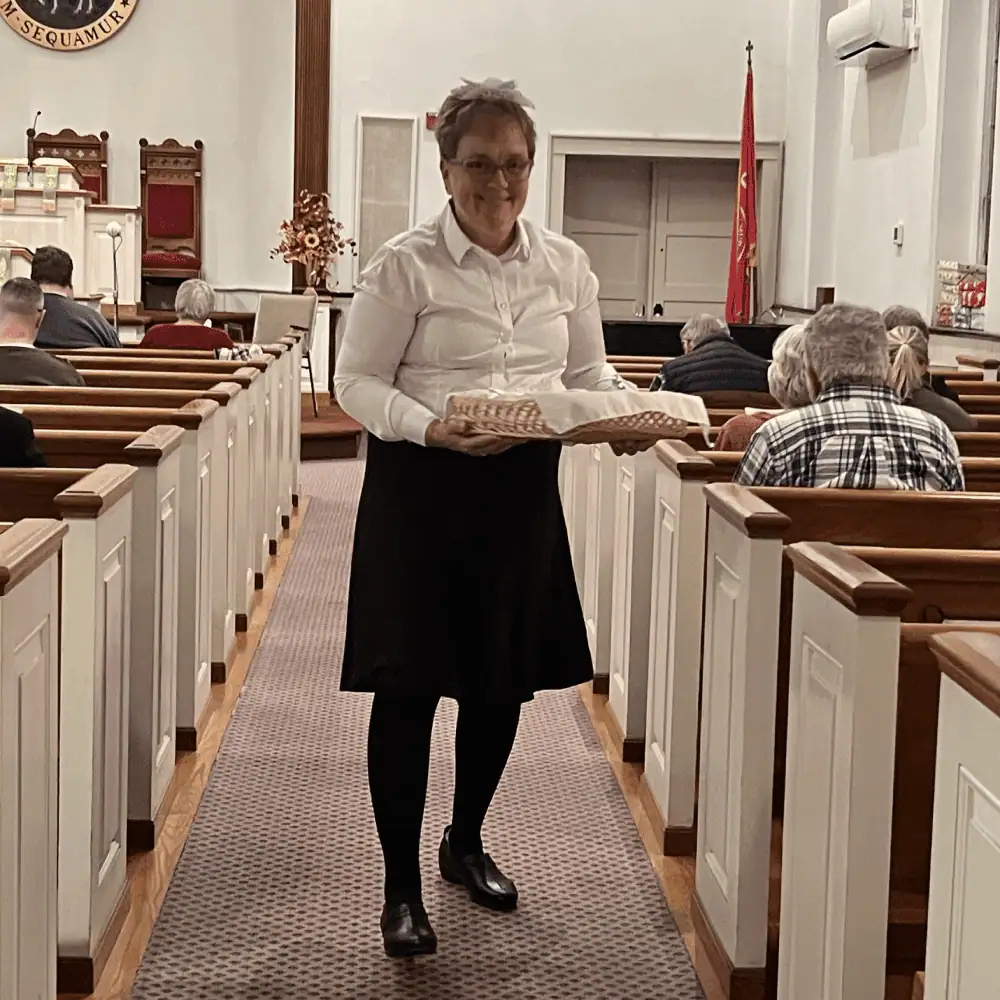
Men wear a white dress shirt with a tie and black pants. Women wear white tops with black bottoms — skirt or pants, your choice. Haubes, a simple, close-fitting cap historically worn by Moravian women, will be provided. (The color of the ribbon on your haube will be related to the old “choir” community system in which the Moravian people lived. Little girls wore bright red ribbons, older girls wore burgundy, single sisters wore pink, married sisters wore blue, and widows wore white ribbons.)
How Often Will I Serve at Lovefeasts?
You will have the opportunity to sign up for the services you prefer to attend. Generally, you’ll choose three or four Lovefeasts plus at least one Christmas Eve service. But the number of services each team will be required to serve is greatly determined by the number of Dieners we have in the Corps.
Diener Corps Interest Form
There’s no such thing as too many Dieners! If you would like more information or want to be a part of this time-honored tradition with the Diener Corps, please fill out the interest form below.
Let’s All Go To The Lovefeast!
Words by Schoeneckian, Troy Schoeneberger
Let’s all go to the Lovefeast,
Let’s all go to the Lovefeast,
Let’s all go to the Lovefeast,
And get ourselves a treat!
Delicious things to eat —
The sugar cake can’t be beat!
The coffee and milk are just dandy;
The Diener carts come in handy,
So let’s all go to the Lovefeast
And get ourselves a treat!
Let’s all go to the Lovefeast…
And get ourselves a treat!
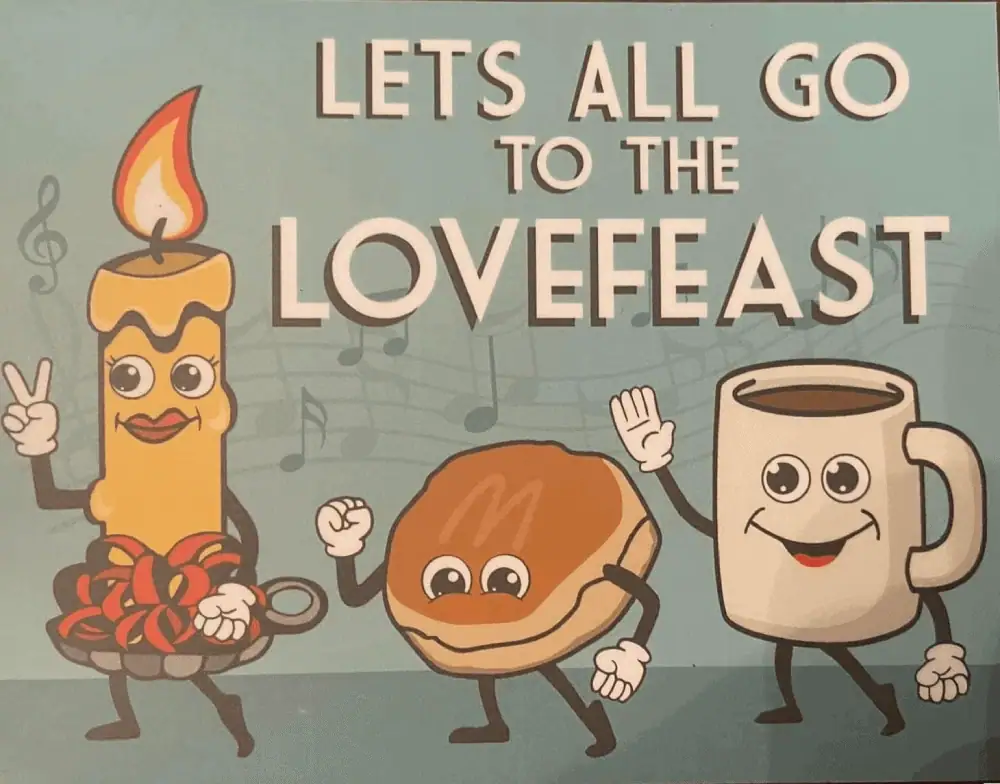
Some of the information on this page is taken from “Customs and Practices of the Moravian Church” by Adelaide L. Fries; updated 2003 by C. Daniel Crewes & Richard Starbuck. © 2003, Interprovincial Board of Communication, Moravian Church in America. All Rights Reserved.
